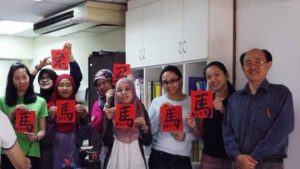Physical Class
Learn Mandarin for Adults & Children
(Beginner)

Our Physical Mandarin Classes Available at:
1) Taman Melawati (HQ)(KL, near National Zoo)
2) PJ (SS25 Taman Mayang)
3) Kajang (Jalan Semenyih)
4) Puchong Prima (beside LRT) & Bandar 16 Sierra
(beside MRT)
5) Pandan Indah (KL)
6) Kota Kinabalu (Sabah)
7) Johor Bahru (Mount Austin & Eco Botani)
8) Rawang (Country Home, Templer Park)
Your progress of learning will be recorded carefully, so student can learn according to their own pace, which mean that every student will be learning individually, and teacher will also be teaching individually in the group according to the student’s level and progress.
So, whether you are fast or slow learner, you no need to feel pressure because others are progressing faster or worry that you need to wait for others if you are learning faster.
The following 3 groups of people are our targeted students:
- Chinese or Non Chinese who do not have formal mandarin education background to join our beginner Mandarin courses that focus more on conversation first. We use the most updated Great Wall Chinese system.
- Those who have been raised in Chinese family and understand mandarin speaking but have no formal mandarin education to join our mandarin characters course.
- Student who had enrolled or plan to enroll in Malaysia Chinese primary school. We will prepare your mandarin foundation to meet the high standard of Chinese school. Thank you for your enquiry and interest in joining our high quality yet affordable Mandarin class.
We provide Beijing standard mandarin, which enable students to master basic mandarin conversation skills, the most frequent used characters in order to equip with daily conversational and reading needs.
We use both e-learning and live in person methods. In other words, we not only provide face to face teaching in classroom, but also provide series of (FREE of Charge for our students) e-learning solutions to help our students after school, such as e-flashcard, video clip to watch, CD-ROM to enhance our students’ skills.
Small Group Class
Package 1 (8 Classes monthly) (please compare our price) A student will be learning in small group (maximum 8 students only) or with family member.
Children
per month
- 8 Lessons
- One & half hour for each lesson.
- Fee to be paid at the first week of every month. We apply monthly fee system, not pay according to attendance.
Teenagers & Adults
per month
- 8 Lessons
- One & half hour for each lesson.
- Fee to be paid at the first week of every month. We apply monthly fee system, not pay according to attendance.
Small Group Class (5 – 7 Students)
Package 2 (4 Classes monthly) (please compare our price) A student study in small group (maximum 8 students only) or with family member.
Children
per month
- 4 Lessons
- Taman Melawati & Kajang Only
- One & the half hour for each lesson.
- Fee to be paid at the first week of every month. We apply monthly fee system, instead of one lump sum course fee.
Teenagers & Adults
per month
- 4 Lessons
- Taman Melawati & Kajang Only
- One & the half hour for each lesson.
- Fee to be paid at the first week of every month. We apply monthly fee system, instead of one lump sum course fee.
Private Class (One-to-One)
For those who prefer individual one to one class, your learning hours will be discussed between you and the teacher.
Children, Teenagers & Adults
per month
- 4 Lessons
- Taman Melawati, Kajang, JB & Rawang
- One & the half hour for each lesson.
- Fee to be paid at the first week of every month. We apply monthly fee system, instead of one lump sum course fee.
- Other packages such as intensive class or holiday class also available based on one’s personal need and financial ability.
Children, Teenagers & Adults
per month
- 8 Lessons
- Taman Melawati, Kajang, JB & Rawang
- One & the half hour for each lesson.
- Fee to be paid at the first week of every month. We apply monthly fee system, instead of one lump sum course fee.
- Other packages such as intensive class or holiday class also available based on one’s personal need and financial ability.
Learn Mandarin Package NPCR – Series
(Advance)

New Practical Chinese Reader is a set of comprehensive Chinese language textbooks compiled for the purpose of teaching Chinese to adult non-native Chinese speakers without previous Chinese learning experience.
The teaching concepts New Practical Chinese Reader upholds are taking language structure as the guideline and combining the teaching of language structure with the teachings of language functions and culture. By placing the focus of study on language structure and functional, cultural knowledge, as well as skills training for listening, speaking, reading and writing, New Practical Chinese Reader aims to foster learners’ ability to communicate in the Chinese language.
It emphasizes the instructions of functional items and covers a wide range of topics. The book is divided into units, making it easy for users to differentiate the core content from the supplementary one and choose the content based on their needs.
Since New Practical Chinese Reader was published in 2002, it has been well received by learners and teachers of Chinese around the world and aroused a lot of concern among them. With its total circulation hitting 1 million copies and its copyright imported to other countries, New Practical Chinese Reader has become one of the most popular basic Chinese teaching resources that are used by world renowneduniversities, such as Harvard University, Stanford University and University of California Berkeley in theUnited States, Toronto University in Canada, Oxford University, Cambridge University and University of London in British, University of Berlin in Germany, University of Melbourne in Australia and Waseda University in Japan.
Its simplified Chinese version and traditional Chinese version with English annotation have been published so far besides its simplified Chinese version with Thai, Russian and Spanish annotations. The books (with CD and CD-ROM) were also annotated in 9 languages in 2009 as a set of comprehensive teaching materials for beginners in cooperation with the Chinese language popularization program launched by Hanban. In addition, the 2nd edition of its simplified Chinese version annotated in English was published in 2010. We haven’t revised the framework, but presented the updated materials in combination with how it was used in the classrooms of foreign countries. The language used is still practical and reality-based so as to foster students’ cross-culture communication skills.
